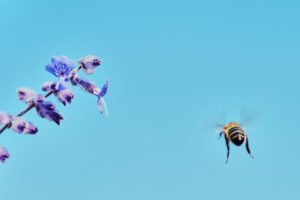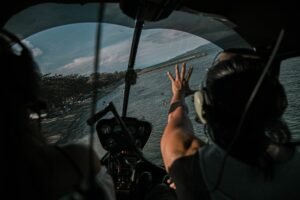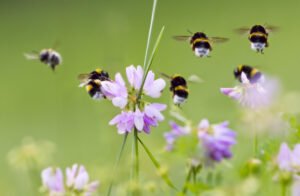Bees Can Fly Higher Than Everest—You Won’t Believe Their True Altitude!
Imagine standing at the bottom of Mount Everest, looking up at its peak—29,032 feet above sea level. Up there, the air is so thin that most people can’t breathe without an oxygen tank. Even helicopters struggle to fly that high. But surprisingly, a tiny bumblebee can.

Scientists used to think that insects couldn’t survive at such high altitudes. After all, even advanced airplanes need special technology to handle those conditions. But once again, nature has proven us wrong.
Researchers have found that some alpine bumblebees can not only survive at these extreme heights but actually fly even higher. In a study, scientists created conditions similar to those on Everest and were shocked to see bees adapting in real time. Instead of struggling, they made a simple change in how they moved their wings. But how do these tiny creatures stay energized in a place with so little oxygen? And what can we learn from their ability to break limits?

Scientists Michael Dillon and Robert Dudley wanted to see just how high a bumblebee could go. They chose alpine bumblebees from Sichuan, China—an area where these bees already live at over 10,000 feet. Instead of following them in the wild, they recreated Everest-like conditions in a lab.
Using a special pressure chamber, they slowly reduced the air pressure to match what it’s like at the highest points on Earth. Normally, insects struggle to fly in thinner air. But what the scientists saw was shocking.
Some of the bees kept flying even at a simulated altitude of 29,527 feet—almost 500 feet higher than Everest! Humans need oxygen tanks and special training to survive at that height, but these tiny bees flew like nothing had changed. Scientists expected them to struggle with less air resistance, but they didn’t. Instead, they adapted in a way no one expected.
How were they doing it? What physical changes allowed them to keep flying when it should have been impossible? The answer was not in flying harder, but in flying smarter.

At first, scientists thought the bees would flap their wings faster to make up for the thin air. But when they recorded the bees in slow motion, they saw something completely different. The bees weren’t flapping faster at all.
Instead, they changed the way they moved their wings. They extended their wing strokes, making wider movements and adjusting the angle of their wings. This allowed them to catch more air with each flap, creating the lift they needed to stay in the sky.
This discovery is amazing because it shows how efficient nature is. Human engineers spend years designing airplane wings for better flight, yet these bees instinctively figured out how to adjust their movement to defy the odds. Their success wasn’t about power—it was about precision.
Even more incredible, the bees didn’t need practice or trial-and-error to figure this out. Unlike pilots, who train for years to fly in extreme conditions, these insects adapted instantly. It raises an interesting question: Is this something they learned over time, or is there a built-in intelligence in nature that helps creatures adjust so quickly?
While this explained how they were able to fly so high, one mystery remained: how did they keep their energy up with so little oxygen?

If a tiny bumblebee can overcome such extreme conditions, what does that say about the limits we place on ourselves?
People are often told that certain things are impossible—that we need more strength, more resources, or better conditions to succeed. But these bees prove that adaptability, not force, is the key to rising higher. They don’t work harder when the air gets thinner; they work smarter.
How often do we face challenges and assume we’ve hit our limit? Whether it’s in our jobs, relationships, or personal goals, we tend to think that pushing harder is the only solution. But maybe, like these bees, we need to change our approach. Maybe we need to shift our strategy, think differently, and find a smarter way forward.
These high-flying bees are more than just impressive insects—they are proof that limits are often in our minds. Nature constantly finds ways to succeed where logic says it shouldn’t. The next time you feel like you’ve reached your peak, ask yourself: Am I really at my limit, or am I just using the wrong approach?
If bees can fly higher than Everest, what other limits have we wrongly assumed?
The bar-headed goose flies over the Himalayas at nearly 30,000 feet, thriving in oxygen levels that would leave most animals gasping. Tardigrades survive in space, enduring radiation and extreme conditions once thought impossible for life.
Science has been proven wrong time and time again. People once believed breaking the sound barrier was impossible—until someone did it. Running a mile in under four minutes was thought to be beyond human ability—until someone achieved it. Deep-sea creatures weren’t supposed to exist in the crushing pressure of the ocean’s depths—until we found them thriving there.
Nature refuses to accept limits. So why should we?
The ability of a bumblebee to fly higher than Everest isn’t just a cool fact—it’s proof of how powerful adaptability is. These tiny creatures don’t fight against the conditions; they adjust. They don’t question whether they can fly at 29,000 feet; they just do it.
We live in a world that tells us to push harder and grind longer to succeed. But maybe real success isn’t about exhausting ourselves. Maybe it’s about adjusting to challenges in a way that makes the impossible possible.
When faced with difficulties, we have a choice: We can let the conditions control us, or we can change the way we move. The bees didn’t fight against thin air—they found a smarter way to fly in it.
The same applies to our lives. Whether it’s personal struggles, career obstacles, or self-doubt, we should ask ourselves: Are we really at our limit, or are we just afraid to change?
The most successful people aren’t always the ones who work the hardest—they’re the ones who adapt the fastest. They recognize when old methods aren’t working and aren’t afraid to try something new.
Like the bumblebee, we are capable of much more than we believe. The sky—no matter how high—never has to be our limit.
